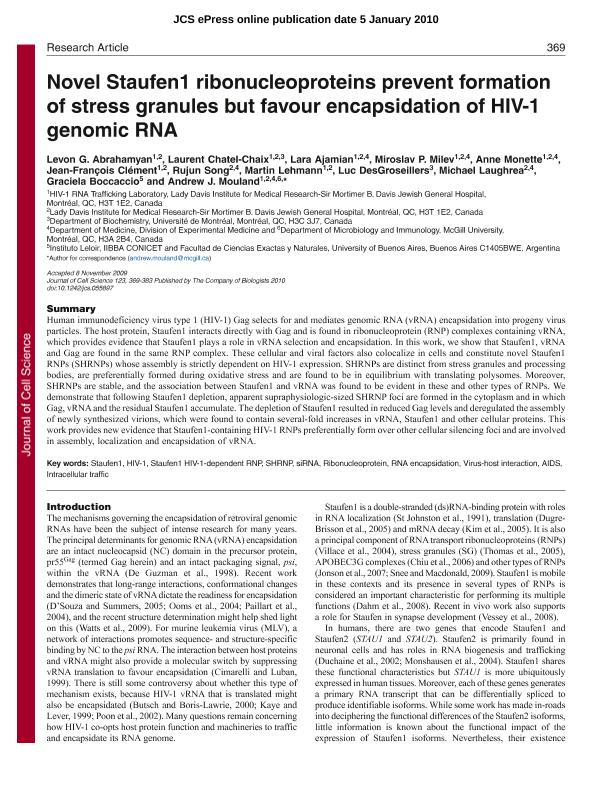Artículo
Novel Staufen1 ribonucleoproteins prevent formation of stress granules but favour encapsidation of HIV-1 genomic RNA
Abrahamyan, Levon G.; Chatel Chaix, Laurent; Ajamian, Lara; Milev, Miroslav P.; Monette, Anne; Clément, Jean François; Song, Rujun; Lehmann, Martin; DesGroseillers, Luc; Laughrea, Michael; Boccaccio, Graciela Lidia ; Mouland, Andrew J.
; Mouland, Andrew J.
 ; Mouland, Andrew J.
; Mouland, Andrew J.
Fecha de publicación:
02/2010
Editorial:
Company Of Biologists
Revista:
Journal Of Cell Science
e-ISSN:
1477-9137
Idioma:
Inglés
Tipo de recurso:
Artículo publicado
Clasificación temática:
Resumen
Human immunodeficiency virus type 1 (HIV-1) Gag selects for and mediates genomic RNA (vRNA) encapsidation into progeny virus particles. The host protein, Staufen1 interacts directly with Gag and is found in ribonucleoprotein (RNP) complexes containing vRNA, which provides evidence that Staufen1 plays a role in vRNA selection and encapsidation. In this work, we show that Staufen1, vRNA and Gag are found in the same RNP complex. These cellular and viral factors also colocalize in cells and constitute novel Staufen1 RNPs (SHRNPs) whose assembly is strictly dependent on HIV-1 expression. SHRNPs are distinct from stress granules and processing bodies, are preferentially formed during oxidative stress and are found to be in equilibrium with translating polysomes. Moreover, SHRNPs are stable, and the association between Staufen1 and vRNA was found to be evident in these and other types of RNPs. We demonstrate that following Staufen1 depletion, apparent supraphysiologic-sized SHRNP foci are formed in the cytoplasm and in which Gag, vRNA and the residual Staufen1 accumulate. The depletion of Staufen1 resulted in reduced Gag levels and deregulated the assembly of newly synthesized virions, which were found to contain several-fold increases in vRNA, Staufen1 and other cellular proteins. This work provides new evidence that Staufen1-containing HIV-1 RNPs preferentially form over other cellular silencing foci and are involved in assembly, localization and encapsidation of vRNA.
Palabras clave:
Hiv
,
Staufen
,
Stress Granule
,
Capside
Archivos asociados
Licencia
Identificadores
Colecciones
Articulos(IIBBA)
Articulos de INST.DE INVEST.BIOQUIMICAS DE BS.AS(I)
Articulos de INST.DE INVEST.BIOQUIMICAS DE BS.AS(I)
Citación
Abrahamyan, Levon G.; Chatel Chaix, Laurent; Ajamian, Lara; Milev, Miroslav P.; Monette, Anne; et al.; Novel Staufen1 ribonucleoproteins prevent formation of stress granules but favour encapsidation of HIV-1 genomic RNA; Company Of Biologists; Journal Of Cell Science; 123; Pte 3; 2-2010; 369-383
Compartir
Altmétricas



